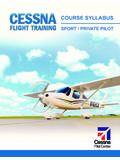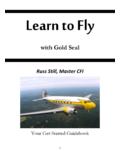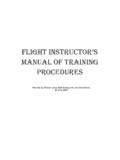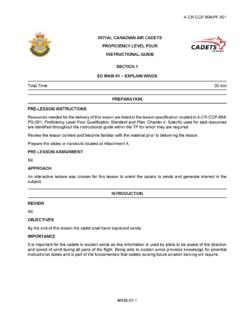Transcription of Advisory Circular - Federal Aviation Administration
1 AC 61-89 EPar1AC No:61-89 ESubject:PILOT CERTIFICATES:AIRCRAFT TYPE RATINGSDate:Initiated by:AFS-840 This Advisory Circular (AC)provides a generic type rating curriculum thatmay serve as a basis for schools to develop atraining program outline (TPO) to meet thetype rating training requirements of Title 14 ofthe Code of Federal Regulations (14 CFR) parts61, 141, and 142. This AC also provides pilotcertificate designations adopted by the FederalAviation Administration (FAA) for aircraft typeratings and standardizes aircraft designationsplaced on pilot certificates to show type AC 61-89D, PilotCertificates: Aircraft Type Ratings, datedFebruary 21, 1991, is Training centers, pilotschools, pilot examiners, and the generalaviation public have a continuing need for atype rating reference such as that provided bythis Circular .
2 This AC provides a guideline forschools and agencies that offer type ratingtraining. Programs operating under 14 CFRparts 121, 135, 141, and 142 that offer onlytype rating training are required to submittraining content of this curriculum(appendix 1) is based on the maneuvers andprocedures of section (e)(1)(2) and onFAA-S-8081-5, Airline Transport Pilot andAircraft Type Rating Practical Test Standards(PTS) for Airplane. The format of thiscurriculum is based on FAA Order ,Air Transportation Operations Inspector sChange:Handbook, which provides detailed informationon training programs for part 121 and part 135operators.
3 This order is available from theSuperintendent of Documents, Box 371954,Pittsburgh, PA 15250-7954. If used, this genericcurriculum should be adapted to include specificdata and characteristics of the aircraft for whichthe type rating is being training requirements:A pilot who has an AMEL certificate limited tocenter thrust or an ASEL certificate to receivea type rating in a multiengine aircraft mustcomplete multiengine land training as part ofthe type rating course. Most airplanes thatrequire type ratings have more than 200horsepower (or the equivalent thrust),pressurization, and service ceilings and/ormaximum operating altitudes above 25,000feet mean sea level.
4 Pilots would therefore berequired to receive both a high-performanceendorsement and a high-altitude endorsementin their logbook or training record before actingas pilot in command of those airplanes. If theydo not have the endorsements when they begintraining for the type rating, the training forthose endorsements may be included in thetype rating curriculum if the airplane for whichthe type rating is required fits the appropriatedescription. However, separate logbook ortraining record endorsements must be issuedfor the type rating, high-performance, and/orhigh-altitude training, as appropriate.
5 If high-performance and high-altitude training isconducted in conjunction with type ratingtraining, the high-performance and high-altitude training should include specificoperational aspects of the airplane. For example,8/4/00AC 61-89E2 Par8/4/004the high-altitude training recommended in AC61-107, High-Altitude Operations, shouldinclude the airplane s particular systems andprocedures for operating at high altitudes(such as the pressurization system and thespecific decompression and emergencydescent procedures described in the AirplaneFlight Manual (AFM) or Pilot's OperatingHandbook (POH)).
6 The requirements ofsection (d)(6)(i) apply to additionalaircraft ratings, the generic curriculum in thisAC may be used for any aircraft that requiresa type rating. Regardless of whether this genericcurriculum is used, it is the responsibility ofeach operator to update its curriculum asnecessary and to adapt that curriculum to thespecific aircraft, flight environment, and typeof flight operations that will be conducted. TheTPO should contain detailed information onthe type of operation, the training environment,and completion standards.
7 The instructionprovided in this curriculum is designed asinitial equipment training and consists ofapproximately 50 hours of ground instruction,15 hours of simulator or training deviceinstruction, and four flights in the airplane (15hours, including ground time). The number ofhours is recommended and may be modified tomeet the training of this AC should be aware thatqualification criteria exists in the most currentissues of AC 120-40, Airplane SimulatorQualification; AC 120-45, Airplane FlightTraining Device Qualification.
8 And part 121,appendix H, Advanced Simulation Plan, forflight simulators and flight duration and specific contentof each lesson will depend on the aircraft forwhich the type rating is sought and on thetype of the operation. For example, if theaircraft is equipped with a simple autopilot,the instruction on autoflight systems maynot take more than half an hour and can becombined with another lesson . However, thepilot may need to undergo more than 2 hoursof instruction before fully understanding theoperation of some sophisticated of different types of operationsthat may affect the length of each lesson arevisual flight rules (VFR) vs.
9 Instrument flightrules (IFR) operations and single pilot or more flight crewmembers. Theinstructor should adjust the curriculumaccordingly, ensuring that the applicableitems contained in appendix 1 are 2 contains a revised list ofaircraft type designations which are placed onpilot 3 specifies the use of thelimitation area on the airman certificate foroperational restrictions associated with typeratings, , N-B-25, VFR ONLY or centerthrust Nicholas LaceyDirector, Flight Standards ServiceAC 61-89 EAppendix 1i8/4/00 APPENDIX 1.
10 CONTENTSSEGMENT 1 - GENERAL OPERATIONAL #1 - Introduction to the Aircraft and Operating Limitations (2 hours)..1 lesson #2 - Weight and Balance (2 hours)..1 lesson #3 - Adverse Weather Practices (2 hours)..2 lesson #4 - Aerodynamics, Performance, Minimum Equipment List (MEL), andConfiguration Deviation List (CDL) (3 hours)..2 lesson #5 - Segment 1 Written 2 - AIRPLANE SYSTEMS AND #6 - Fuel and Oil Systems (3 hours)..3 lesson #7 - Powerplant(s) (3 hours)..3 lesson #8 - Electrical System (2 hours).

















